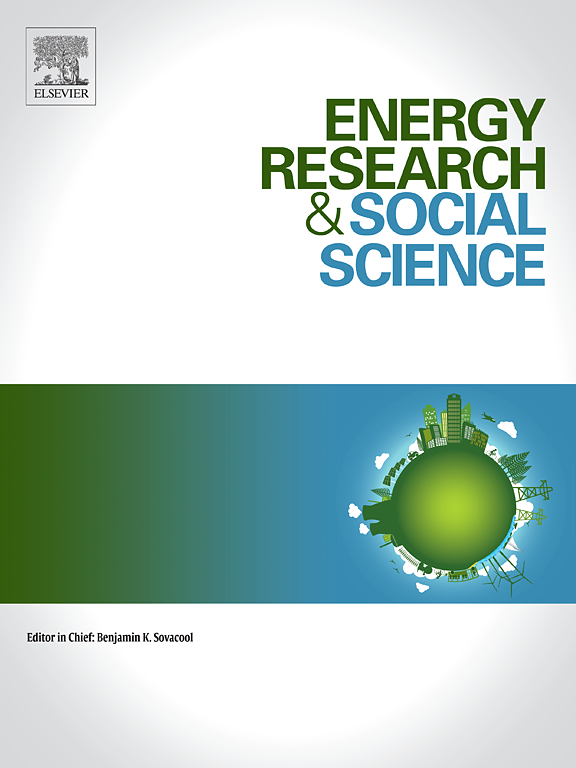Siting bioenergy facilities in the United States: Measuring participation in decisions and distribution of effects
IF 6.9
2区 经济学
Q1 ENVIRONMENTAL STUDIES
引用次数: 0
Abstract
Indicators are crucial for measuring progress in sustainability, community development, and energy equity objectives. Thus, indicators are vital for siting or repurposing energy facilities, revealing benefits and adverse effects on underserved communities compared to those under baseline or alternative conditions. However, the use of quantitative metrics can reduce the assessment of progress to a technical exercise of data collection, frequently lacking citizen participation. In this paper, we emphasize the importance of incorporating procedural and distributional justice into the siting process, through the identification of indicators aimed at avoiding the perpetuation of or increase in socioeconomic disparities. More specifically, we describe the process through which a diverse committee of US agriculture, energy, and environmental justice stakeholders and experts, along with US energy researchers, collaboratively developed a list of indicators reflecting justice objectives for siting bioenergy. Stakeholders emphasized categories of procedural justice indicators such as trust, influence, informed consent, and private property rights, whereas energy burden, for example, was identified as an important distributional justice indicator. The proposed indicators can be selected or modified to reflect local needs and priorities. This paper demonstrates that indicators can be developed through participatory processes to guide stakeholders to make informed decisions regarding siting and permitting of biorefineries or biopower facilities. These indicators enable the comparison of siting options; early identification of key problems, concerns, or priorities; and tracking of progress toward justice-related targets. Ultimately, this approach contributes to a more equitable and sustainable energy transition.
美国生物能源设施选址:衡量参与决策和分配效果
指标对于衡量可持续性、社区发展和能源公平目标的进展至关重要。因此,指标对于能源设施的选址或重新利用至关重要,与基线或替代条件下的社区相比,这些指标揭示了对服务不足社区的好处和不利影响。然而,使用数量计量方法会使对进展的评估沦为收集数据的技术性工作,往往缺乏公民的参与。在本文中,我们强调通过确定旨在避免社会经济差距持续存在或增加的指标,将程序和分配正义纳入选址过程的重要性。更具体地说,我们描述了一个由美国农业、能源和环境正义利益相关者和专家组成的多元化委员会,以及美国能源研究人员共同制定了一份反映生物能源选址正义目标的指标清单的过程。利益攸关方强调了信任、影响、知情同意和私有产权等程序正义指标类别,而能源负担等则被确定为重要的分配正义指标。可以选择或修改拟议的指标,以反映当地的需要和优先事项。本文表明,可以通过参与性过程制定指标,以指导利益相关者就生物精炼厂或生物发电设施的选址和许可做出明智的决策。这些指标有助于比较选址方案;及早发现关键问题、关注点或优先事项;以及追踪司法相关目标的进展情况。最终,这种方法有助于实现更加公平和可持续的能源转型。
本文章由计算机程序翻译,如有差异,请以英文原文为准。
求助全文
约1分钟内获得全文
求助全文
来源期刊

Energy Research & Social Science
ENVIRONMENTAL STUDIES-
CiteScore
14.00
自引率
16.40%
发文量
441
审稿时长
55 days
期刊介绍:
Energy Research & Social Science (ERSS) is a peer-reviewed international journal that publishes original research and review articles examining the relationship between energy systems and society. ERSS covers a range of topics revolving around the intersection of energy technologies, fuels, and resources on one side and social processes and influences - including communities of energy users, people affected by energy production, social institutions, customs, traditions, behaviors, and policies - on the other. Put another way, ERSS investigates the social system surrounding energy technology and hardware. ERSS is relevant for energy practitioners, researchers interested in the social aspects of energy production or use, and policymakers.
Energy Research & Social Science (ERSS) provides an interdisciplinary forum to discuss how social and technical issues related to energy production and consumption interact. Energy production, distribution, and consumption all have both technical and human components, and the latter involves the human causes and consequences of energy-related activities and processes as well as social structures that shape how people interact with energy systems. Energy analysis, therefore, needs to look beyond the dimensions of technology and economics to include these social and human elements.
 求助内容:
求助内容: 应助结果提醒方式:
应助结果提醒方式:


